Updated European weather outlook for June and July 2025

The updated European weather trend for June and July 2025
The outlook continues to indicate widespread warmer conditions across much of Europe. The likelihood of above-average temperatures is higher in the UK, western-central and central-southern parts of Europe. In other areas, temperatures could be closer to the seasonal average or even temporarily below it, e.g. parts of Scandinavia/north-eastern Europe or at times in south-eastern Europe/Turkey. Noteworthy is the absence of prolonged cold anomalies until around mid-summer. Neutral or slightly positive Nort-Atlantic Oscillation (NAO) patterns are likely to mostly prevail during this period. However, the latter conditions could go hand in hand with a northerly frontal zone and possible split jet stream configurations. This would mean lower pressure across northwestern and at times northern and northeastern Europe, higher pressure in the mid-latitudes and lower pressure in portions of southern and southeastern Europe.
As a result, June could see a return to somewhat drier and mostly calmer weather (see forecast charts below), along with the first signs of early heat stress. Persistent regional droughts in large parts of the mid-latitudes of Europe, including also parts of the UK are likely to be exacerbated by low soil moisture in spring.
The tropospheric memory of an observed split or weaker westerly jet stream in the North Atlantic region in spring could play a role later in the summer. This would exacerbate the risks mentioned above. For now, early June could turn out to be wetter or close to average rainfall amounts.
As for the ongoing high-pressure predominance, other factors could come into play, e.g. the North Atlantic Basin has seen above-average temperatures for a long period and is expected to stay warmer than normal, albeit somewhat cooler compared to 2024. Furthermore, anomalous warmth in the Arctic has led to record low sea-ice extent. The latter conditions might support high-pressure patterns in the North Atlantic-Scandinavian region within the sub-seasonal to seasonal forecast horizon, in-line with some research papers.
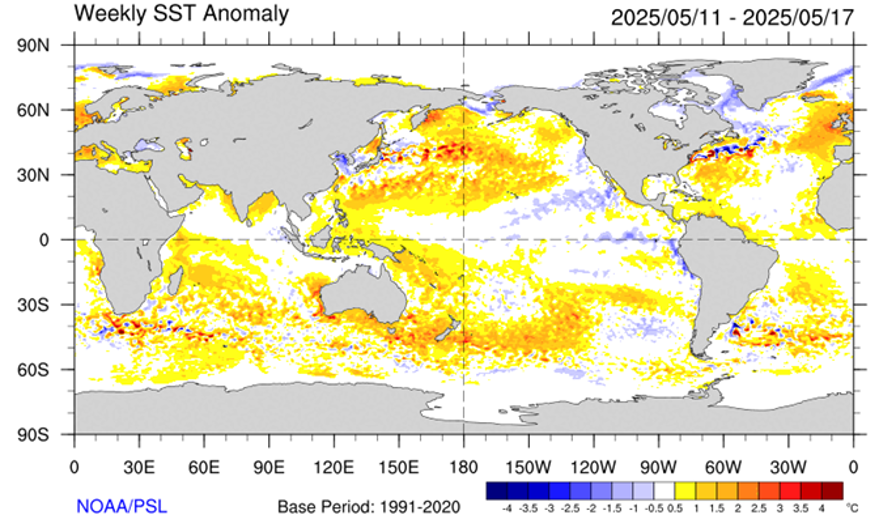
Related to this, see the latest weekly sea-surface temperature anomalies above.
A dipole has formed, with cooler waters near the eastern coast of the US and Canada and toward Greenland. This contrasts with significantly warmer waters from Iceland to the UK/Ireland and even further south due to a marine heatwave that developed in boreal spring. This is mainly due to an established stubborn “trough-ridge” pattern in this area and may indicate possible two-way feedback between the atmosphere and sea surface in the S2S range.
The prevailing weather regimes into summer
The likelihood of a positive NAO regime is higher through early June, accompanied by a somewhat more active North Atlantic pattern. See the latest EC’s W.R.F. chart below. However, a frontal zone shifting northwards brings lower pressure to the far northwest of Europe and at times extends as far as Scandinavia. Higher pressure could build up in the mid-latitudes then, meaning that the NAO index could remain neutral to slightly positive, see the chart below.
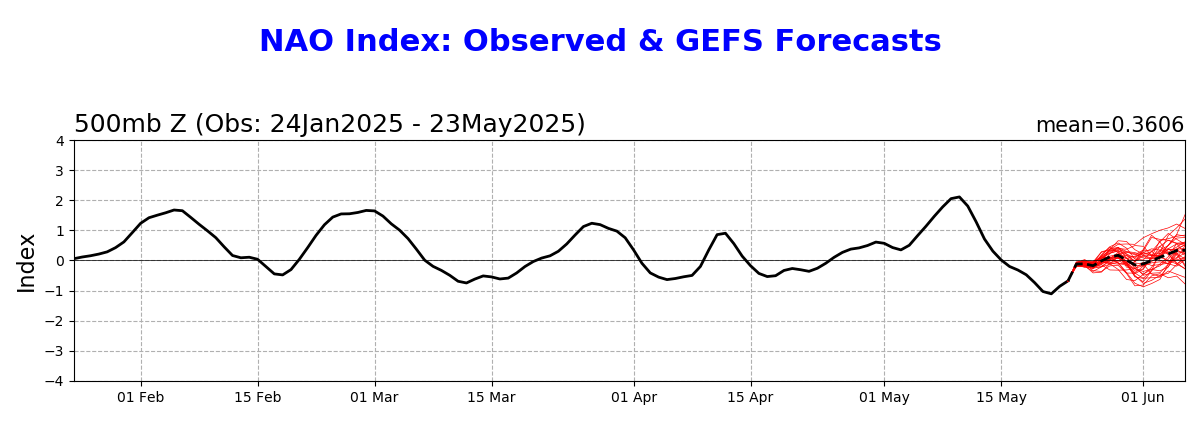
As a result, it is likely to become drier-than-usual again in large parts of western and central Europe, with temperatures climbing well above average at times. It could get very warm across southwestern and southern Europe in particular. Southwestern Europe, the Iberian Peninsula and parts of Eastern Europe could also become drier and calmer.
Toward the end of June and into July, some changes in the prevailing weather conditions are expected, in particular an increasing likelihood of high-pressure blockings in various forms.
Further insights can be found in EC’s W.R.F.
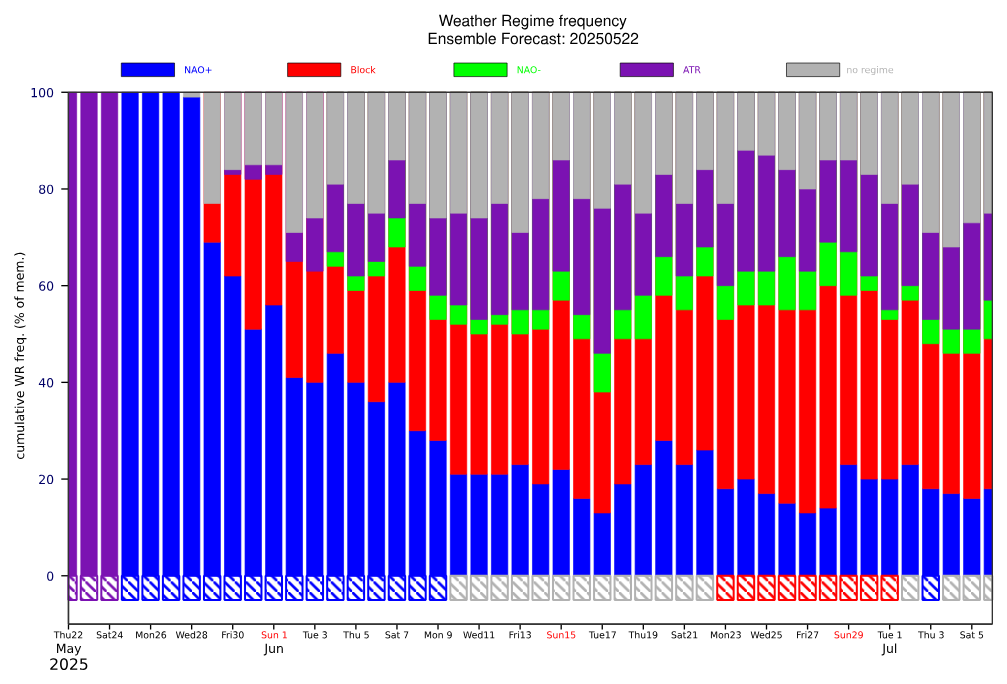
Source: ECMWF Reading, UK
The European summer forecast by C3S multi-system seasonal forecast
The latest multi-system seasonal forecast in terms of mean 2m temperature and mean precipitation anomaly, and weather forecast models are below.
Also, see also the conclusions and graphics from the C3S website for the June, July and August Referencing the Copernicus seasonal forecast, “There is high uncertainty in the forecast of patterns of atmospheric circulation over the European region for the summer However, there are confident predictions of above-average European summer temperatures, from all nine models contributing to C3S. Probabilities for well-above-average temperature are much enhanced from climatological values, virtually throughout Europe.”
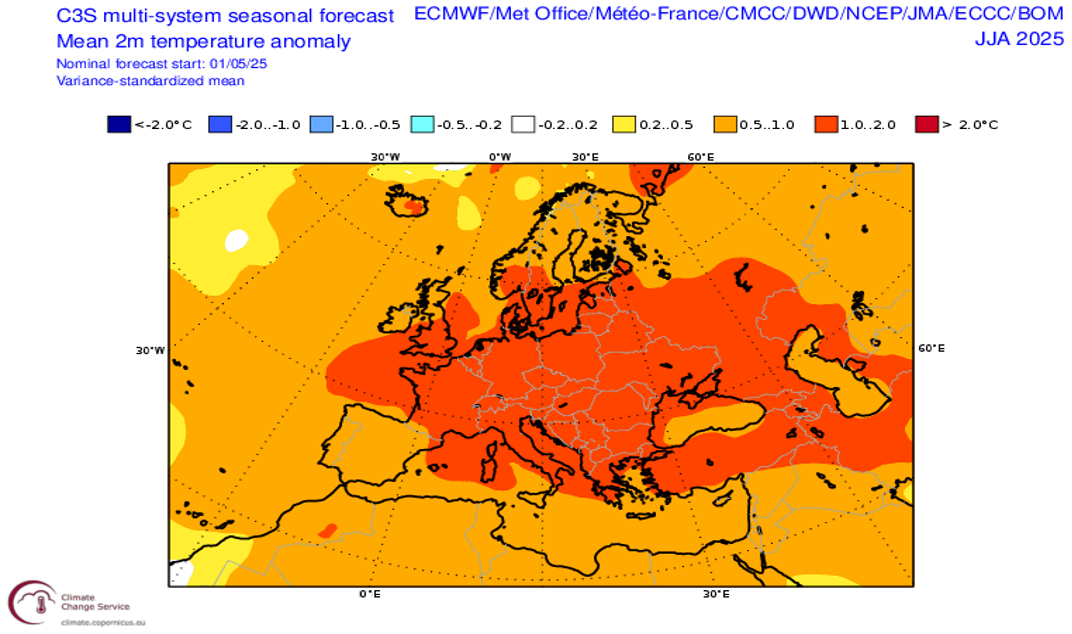
“There is much less clear indication for rain than for temperature, but the small tilt of probabilities (from climatological values) is towards drier-than-usual conditions, especially over the eastern part of the continent.” Visit here for more information.
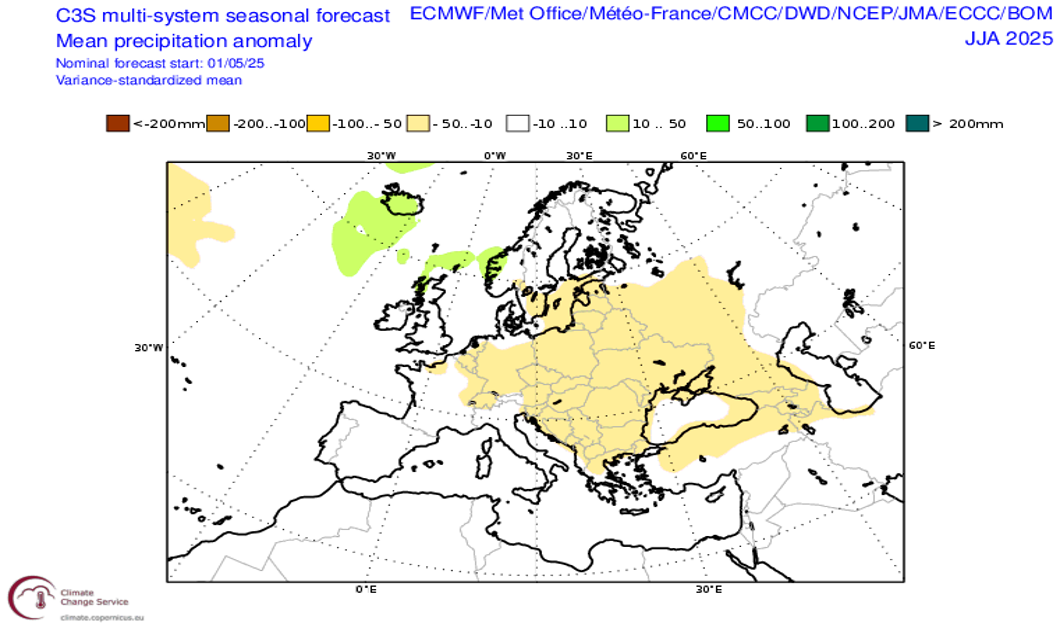
DTN forecast charts for June and July
Contrary to C3S forecasts, DTN does not anticipate strong warm anomalies in Europe, at least for June and July. Some areas could be closer to seasonal average temperatures or even below average at times. For example, Scandinavia and parts of north-eastern Europe could see slightly cooler conditions at times, which aligns with the latest DTN forecast.
Furthermore, the latter would mean a slightly negative NAO index at times, which is in line with the expectations of the DIN long-term forecast team and would counteract the development of very warm conditions across Europe to a certain extent.
There is good agreement regarding the expected widespread drier conditions, with widespread lower winds, however.
The latest temperature, precipitation, and wind departure forecasts for June and July by DTN are shown below.

Conclusion
Generally wetter and windier into June followed by widespread drier and calmer conditions, except for northwestern, northern and northeastern Europe and occasionally in southeastern Europe and Turkey. Prolonged drought and heat stress risks are increasing. Good solar outputs.

About the author
Dr. Jens Bonewitz
Dr. Jens Bonewitz is an experienced long-range energy meteorologist at DTN. He consults with utility and renewable energy clients to help plan and prepare for the impact of weather. He combines research and its practical applications to produce meaningful weather forecasts within the S2S range.











 Comprehensive weather insights help safeguard your operations and drive confident decisions to make everyday mining operations as safe and efficient as possible.
Comprehensive weather insights help safeguard your operations and drive confident decisions to make everyday mining operations as safe and efficient as possible. Learn how to optimize operations with credible weather and environmental intelligence. From aviation safety to environmental compliance, our comprehensive suite of solutions delivers real-time insights, advanced forecasting, and precise monitoring capabilities.
Learn how to optimize operations with credible weather and environmental intelligence. From aviation safety to environmental compliance, our comprehensive suite of solutions delivers real-time insights, advanced forecasting, and precise monitoring capabilities. 

